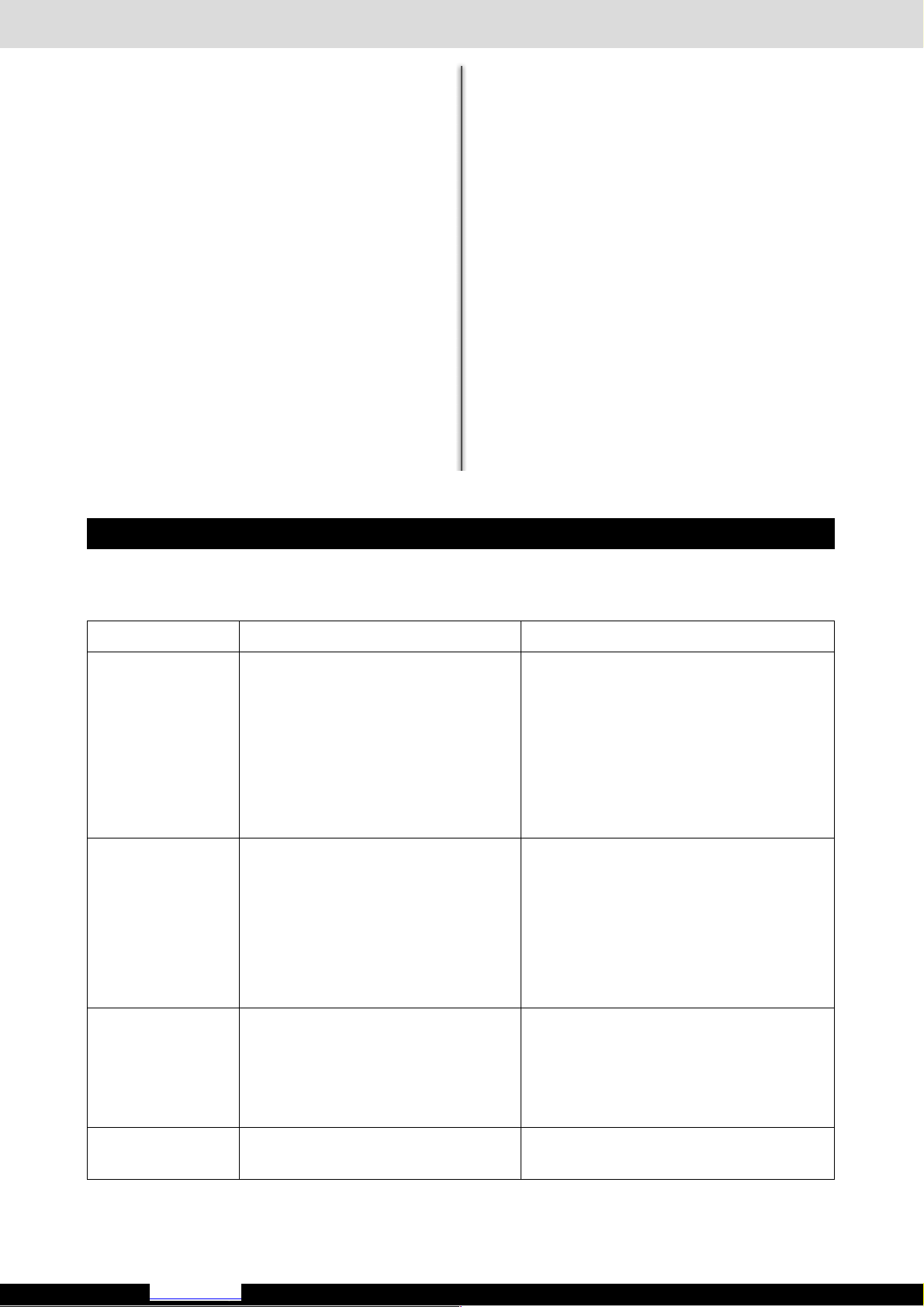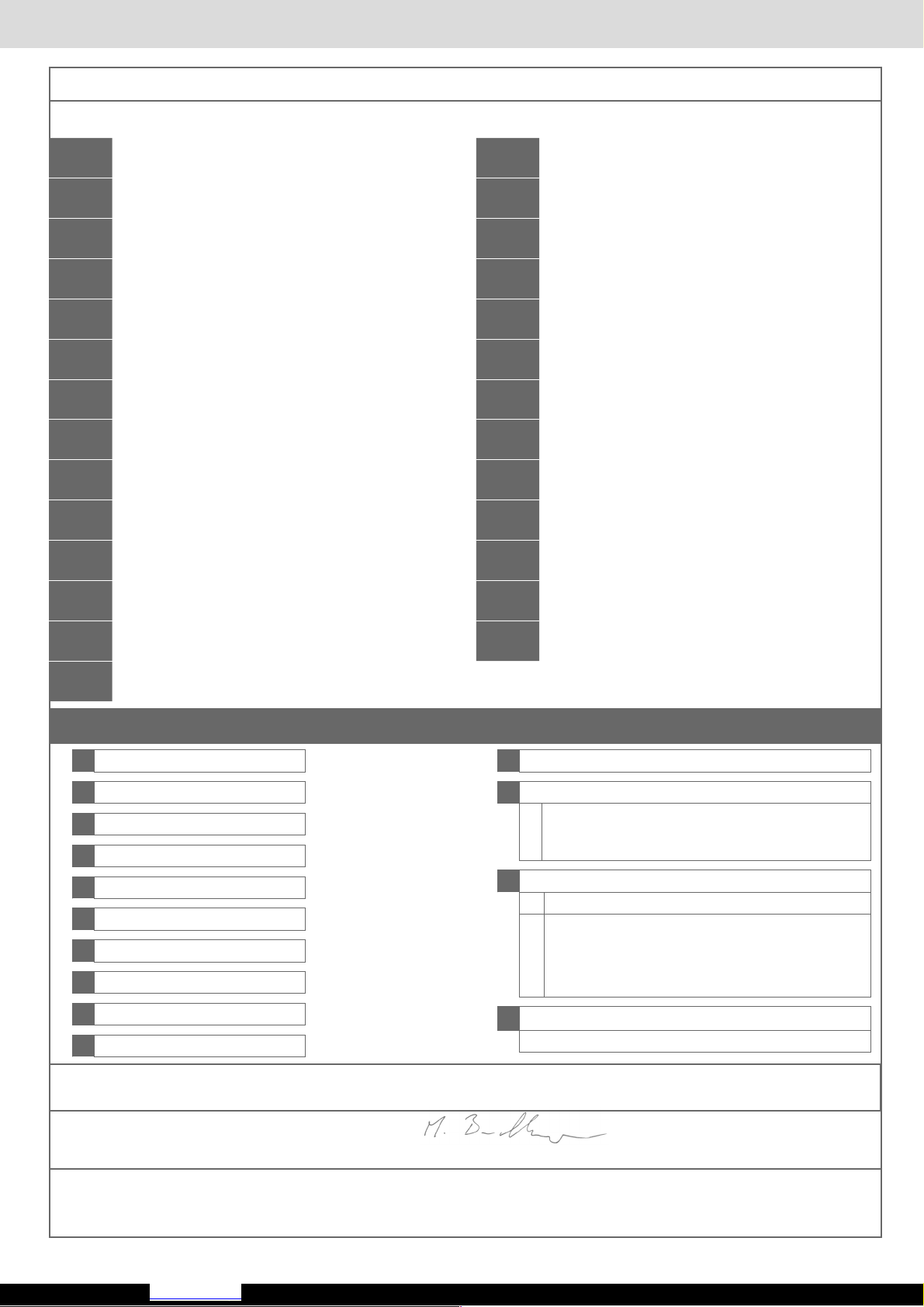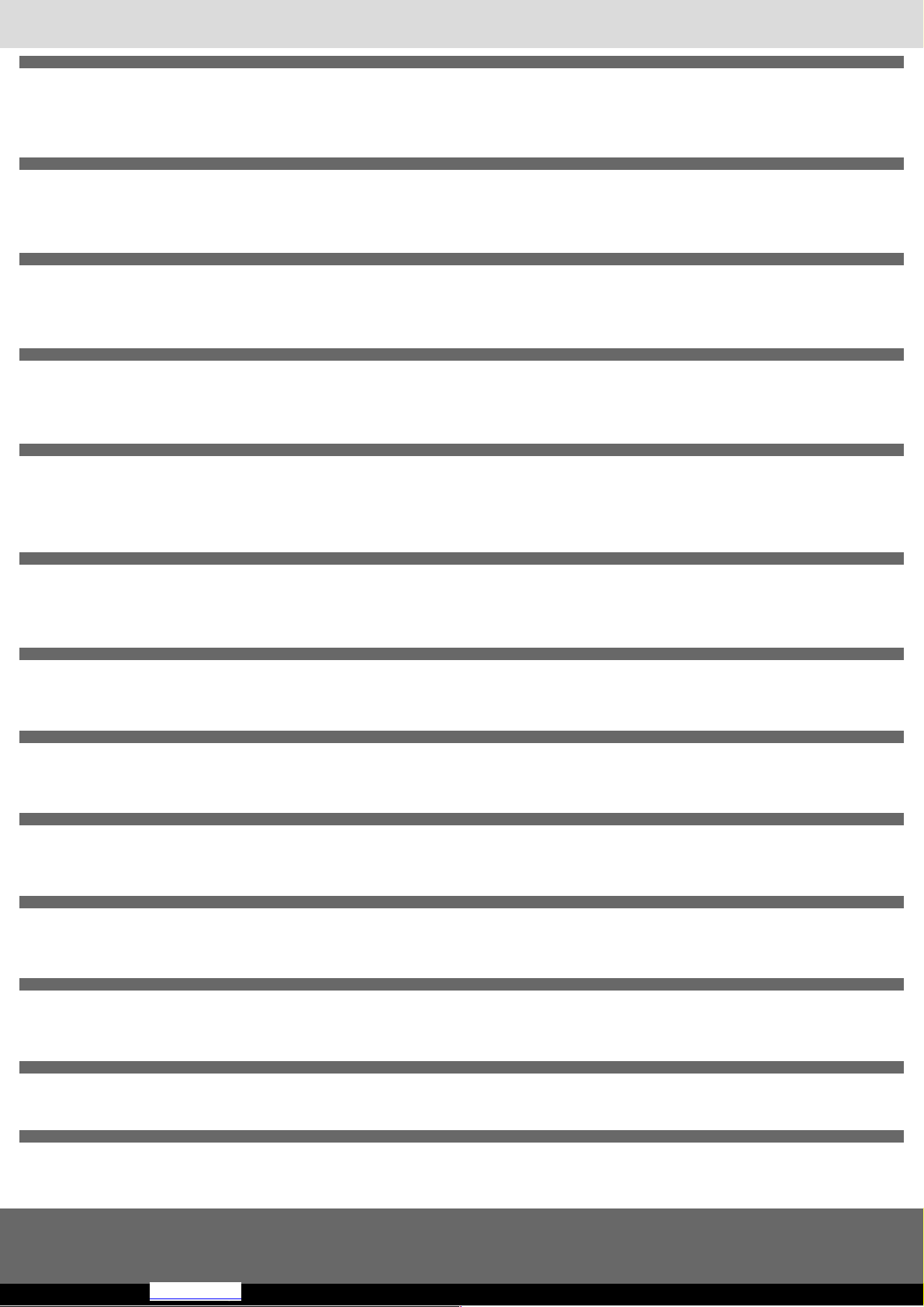www.scheppach.com service@scheppach.com +(49)-08223-4002-99 +(49)-08223-4002-58
Garantie DE
Offensichtliche Mängel sind innerhalb von 8 Tagen nach Erhalt der Ware anzuzeigen, andern-
falls verliert der Käufer sämtliche Ansprüche wegen solcher Mängel. Wir leisten Garantie für
unsere Maschinen bei richtiger Behandlung auf die Dauer der gesetzlichen Gewährleistungsfrist
ab Übergabe in der Weise, dass wir jedes Maschinenteil, dass innerhalb dieser Zeit nachweisbar
in Folge Material- oder Fertigungsfehler unbrauchbar werden sollte, kostenlos ersetzen. Für
Teile, die wir nicht selbst herstellen, leisten wir nur insoweit Gewähr, als uns Gewährleistungsan-
sprüche gegen die Vorlieferanten zustehen. Die Kosten für das Einsetzen der neuen Teile trägt
der Käufer. Wandlungs- und Minderungsansprüche und sonstige Schadensersatzansprüche
sind ausgeschlossen.
Warranty GB
Apparent defects must be notied within 8 days from the receipt of the goods. Otherwise, the
buyerís rights of claim due to such defects are invalidated. We guarantee for our machines in
case of proper treatment for the time of the statutory warranty period from delivery in such a
way that we replace any machine part free of charge which provably becomes unusable due
to faulty material or defects of fabrication within such period of time. With respect to parts not
manufactured by us we only warrant insofar as we are entitled to warranty claims against the
upstream suppliers. The costs for the installation of the new parts shall be borne by the buyer.
The cancellation of sale or the reduction of purchase price as well as any other claims for dam-
ages shall be excluded.
Garantie FR
Les défauts visibles doivent être signalés au plus tard 8 jours après la réception de la marchan-
dise, sans quoi l’acheteur perd tout droit au dédommagement.
Nous garantissons nos machines, dans la mesure où elles sont utilisées de façon conforme,
pendant la durée légale de garantie à compter de la réception, sachant que nous remplaçons
gratuitement toute pièce de la machine devenue inutilisable du fait d’un défaut de matière ou
d’usinage durant cette période. Toutes les pièces que nous ne fabriquons pas nous-mêmes ne
sont garanties que si nous avons la possibilité d’un recours en garantie auprès des fournisseurs
respectifs. Les frais de main d’œuvre occasionnés par le remplacement des pièces sont à la
charge de l’acquéreur. Tous droits à rédhibition et toutes prétentions à une remise ainsi que tous
autres droits à dommages et intérêts sont exclus
Garanzia IT
Vizi evidenti vanno segnalati entro 8 giorni dalla ricezione della merce, altrimenti decadono tutti
i diritti dellíacquirente inerenti a vizi del genere. Appurato un impiego corretto da parte dellíacq-
uirente, garantiamo per le nostre macchine per tutto il periodo legale di garanzia a decorrere
dalla consegna in maniera tale che sostituiamo gratuitamente qualsiasi componente che entro
tale periodo presenti dei vizi di materiale o di fabbricazione tali da renderlo inutilizzabile. Per
componenti non fabbricati da noi garantiamo solo nella misura nella quale noi stessi possiamo
rivendicare diritti a garanzia nei confronti dei nostri fornitori. Le spese per il montaggio dei
componenti nuovi sono a carico dellíacquirente. Sono escluse pretese di risoluzione per vizi, di
riduzione o ulteriori pretese di risarcimento danni.
Garantie NL
Zichtbare gebreken moeten binnen de 8 dagen na ontvangst van de goederen worden gemeld,
zo niet verliest de verkoper elke aanspraak op grond van deze gebreken. Onze machines
worden geleverd met een garantie voor de duur van de wettelijke garantietermijn. Deze termijn
gaat in vanaf het moment dat de koper de machine ontvangt. De garantie houdt in dat wij elk
onderdeel van de machine dat binnen de garantietermijn aantoonbaar onbruikbaar wordt als
gevolg van materiaal- of productiefouten, kosteloos vervangen. De garantie vervalt echter bij
verkeerd gebruik of verkeerde behandeling van de machine. Voor onderdelen die wij niet zelf
produceren, geven wij enkel de garantie die wij zelf krijgen van de oorspronkelijke leverancier.
De kosten voor de montage van nieuwe onderdelen vallen ten laste van de koper. Eisen tot het
aanbrengen van veranderingen of het toestaan van een korting en overige schadeloosstellings-
claims zijn uitgesloten.
Garantía ES
Los defectos evidentes deberán ser noticados dentro de 8 días después de haber recibido la
mercancía, de lo contrario el comprador pierde todos los derechos sobre tales defectos. Ga-
rantizamos nuestras máquinas en caso de manipulación correcta durante el plazo de garantía
legal a partir de la entrega. Sustituiremos gratuitamente toda pieza de la máquina que dentro
de este plazo se torne inútil a causa de fallas de material o de fabricación. Las piezas que no
son fabricadas por nosotros mismos serán garantizadas hasta el punto que nos corresponda
garantía del suministrador anterior. Los costes por la colocación de piezas nuevas recaen sobre
el comprador. Están excluidos derechos por modicaciones, aminoraciones y otros derechos de
indemnización por daños y perjuicios.
Garantia PT
Para este aparelho concedemos garantia de 24 meses. A garantia cobre exclusivamente
defeitos de matérial ou de fabricação. Peças avariadas são substituidas gratuitamente. cabe ao
cliente efetuar a substituição. Assumimos a garantia unicamente de peças genuinas.
Não há direito à garantia no caso de: peças de desgaste, danos de transporte, danos causados
pelo manejo indevido ou pela desatenção as instruções de serviço, falhas da instalação elétrica
por inobservançia das normas relativas á electricidade. Além disso, a garantia só poderá ser
reinvidicada para aparelhos que não tenham sido consertados por lerceiros. O cartão de garan-
tia só vale em conexão com a fatura.
Gwarancja PL
Wszelkie uszkodzenia muszą być zgłaszane w przeciągu 8 dni od daty otrzymania towaru, w
przeciwnym wypadku, prawo do reklamacji wygasa. Gwarantujemy, że w czasie trwania gwarancji
wymienimy wszelkie części maszyny, które okażą się niesprawne na skutek wad materiału z jakie-
go zostały wykonane lub błędów w produkcji bez dodatkowych opłat pod warunkiem, że maszyna
będzie obsługiwana zgodnie z zaleceniami. W odniesieniu do części nie produkowanych przez
nas, gwarancja obowiązuje tylko w przypadku naszych dostawców. Koszty instalacji nowych części
są ponoszone przez klienta. Odszkodowania wynikłe z uszkodzeń maszyny oraz redukcje ceny
zakupu maszyny w ramach reklamacji nie będą rozpatrywane.
Takuu FI
Ilmeisistä puutteista tulee ilmoittaa kahdeksan päivän kuluessa tavaran vastaanottamisesta.
Muutoin ostaja ei voi vaatia korvausta ko. puutteista. Annamme takuun oikein käsitellyille
koneillemme lakisääteiseksi takuuajaksi tavaran luovutuksesta alkaen siten, että vaihdamme
korvauksetta minkä tahansa koneenosan, joka osoittautuu tämän ajan kuluessa käyttökelvot-
tomaksi raaka-aine- tai valmistusvirheestä johtuen. Osille, joita emme valmista itse, annamme
takuun vain mikäli osien toimittaja on antanut niistä takuun meille. Uusien osien asennuskus-
tannukset maksaa ostaja. Purku- ja vähennysvaatimukset ja muut vahingonkorvausvaatimukset
eivät tule kysymykseen.
Záruka CZ
Viditelné vady jsou poukazatelné během 8 dní od obdržení zboží, jinak ztrácí zákazník všechny
nároky týkající se takovýchto vad. Poskytujeme záruku na naše stroje, s kterými je správně
zacházeno, na dobu zákonnné záruční lhůty začínající od doručení tak, že bezplatně vyměníme
každou část stroje, která se během této doby může stát prokazatelně nepoužitelnou následkem
materiálové či výrobní vady. Na díly, které sami neopravujeme, poskytujeme záruku pouze v
rozsahu , v němž nám přísluší nárok na záruční plnění vůči subdodavateli . Náklady na instalaci
nového dílu nese zákazník. Nárok na výměnu zboží, na slevu a jiné nároky na odškodnění jsou
vyloučené.
Záruka SK
Zrejmé vady musia byť predstavené v priebehu 8 dni po obdržaní tovaru, ináč zákazník stratí
všetky nároky týkajúce sa takejto vady. Ponúkame záruku na naše aparáty, ktoré sú správne
používané počas zákonného termínu záruky tak, že bezplatne vymeníme každú časť aparátu,
ktorá sa v priebehu tohto času môže stať dokázateľne nefunkčnou dôsledkom materiálnej či
výrobnej vady. Na časti ktoré sami nevyrábame, poskytujeme záruku iba v rozsahu, v ktorom
nám prísluší nárok na záručné plněnie k subdodávateľovi. Za trovy týkajúce sa inštalácie novej
súčiastky je zodpovedný zákazník. Nárok na výmenu tovara, na zľavu a iné nároky na nahrade-
nie škody sú vylúčené.
Garancija SI
Očitne pomanjkljivosti je potrebno naznaniti 8 dni po prejemu blaga, v nasprotnem primeru
izgubi kupec vse pravice do garancije zaradi takšnih pomanjkljivosti. Za naše naprave dajemo
garancijo ob pravilni uporabi za čas zakonsko določenega roka garancije od predaje in sicer
na takšen način, da vsak del naprave brezplačno nadomestimo, za katerega bi se v tem roku
izkazalo, da je zaradi slabega materiala ali slabe izdelave neuporaben. Za dele, ki jih sami ne
izdelujemo, jamčimo samo toliko, kolikor zahteva garancija drugih podjetij. Stroški za vstavljanje
novih delov nosi kupec. Zahteve za spreminjanje in zmanjšanje ter ostale zahteve za nadomesti-
lo škode so izključene.
Szavatosság HU
A nyilvánvaló hibákat ki kell jelenteni számított 8 napon belül az áruk, különben a vevő elveszti
minden igényt az ilyen hibák. Kínálunk garanciát a gépeinket a megfelelő kezelés időtartamának
hallgatólagos garancia a szállítás időpontját oly módon, hogy cserélje ki minden egyes része ezen
idő alatt észlelhető a sorban anyag-vagy gyártási legyen hiábavaló, ingyen. Az alkatrészeket, hogy
nem termel magunkat, hogy csak olyan garanciát, hiszen jogosultak jótállási igények beszállítókkal
szemben. A költségek beillesztése az új részek a vevőnek. Átalakítása és csökkentése
követelések és egyéb kártérítési igények ki vannak zárva.
scheppach Fabrikation von Holzbearbeitungsmaschinen GmbH | Günzburger Str. 69 |
D-89335 Ichenhausen | www.scheppach.com







































































































